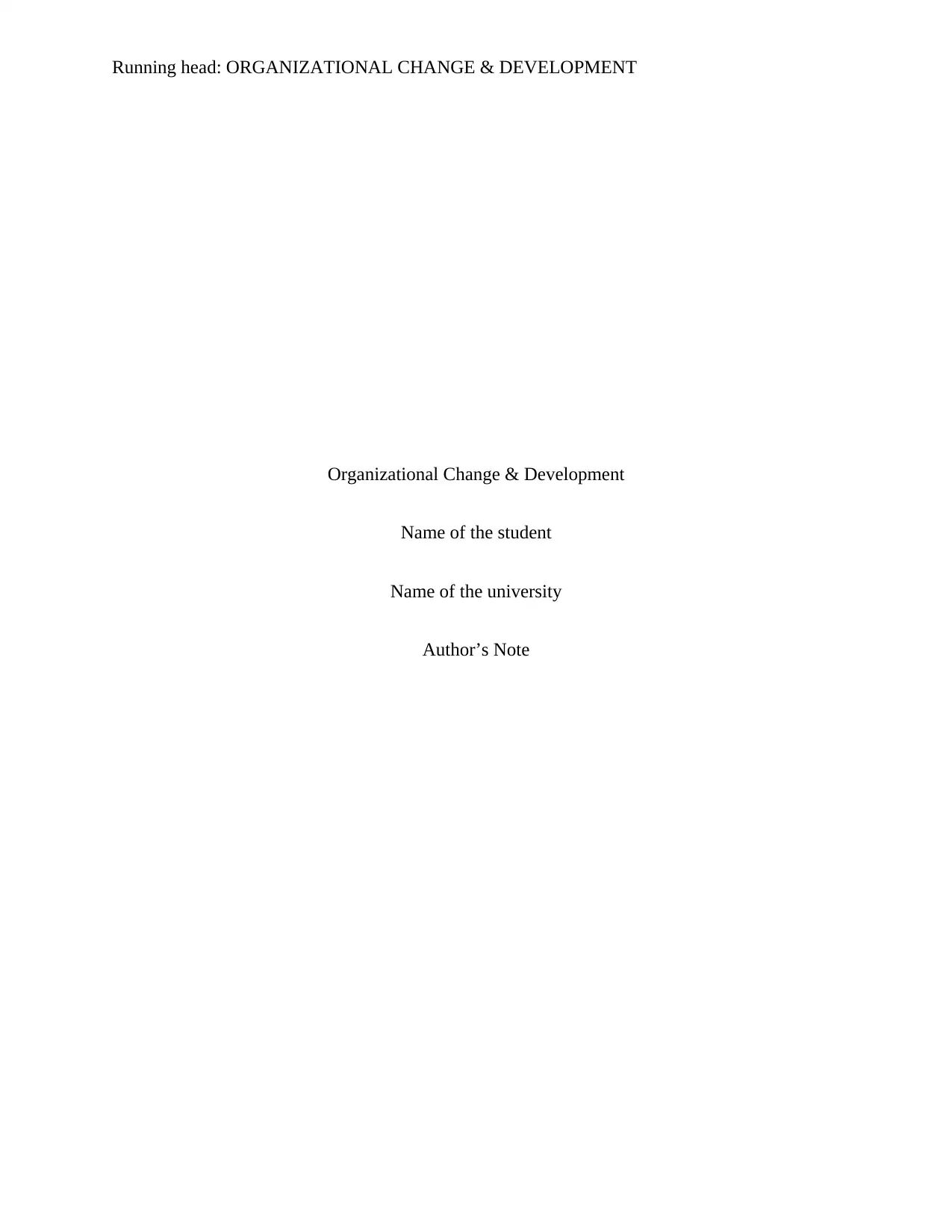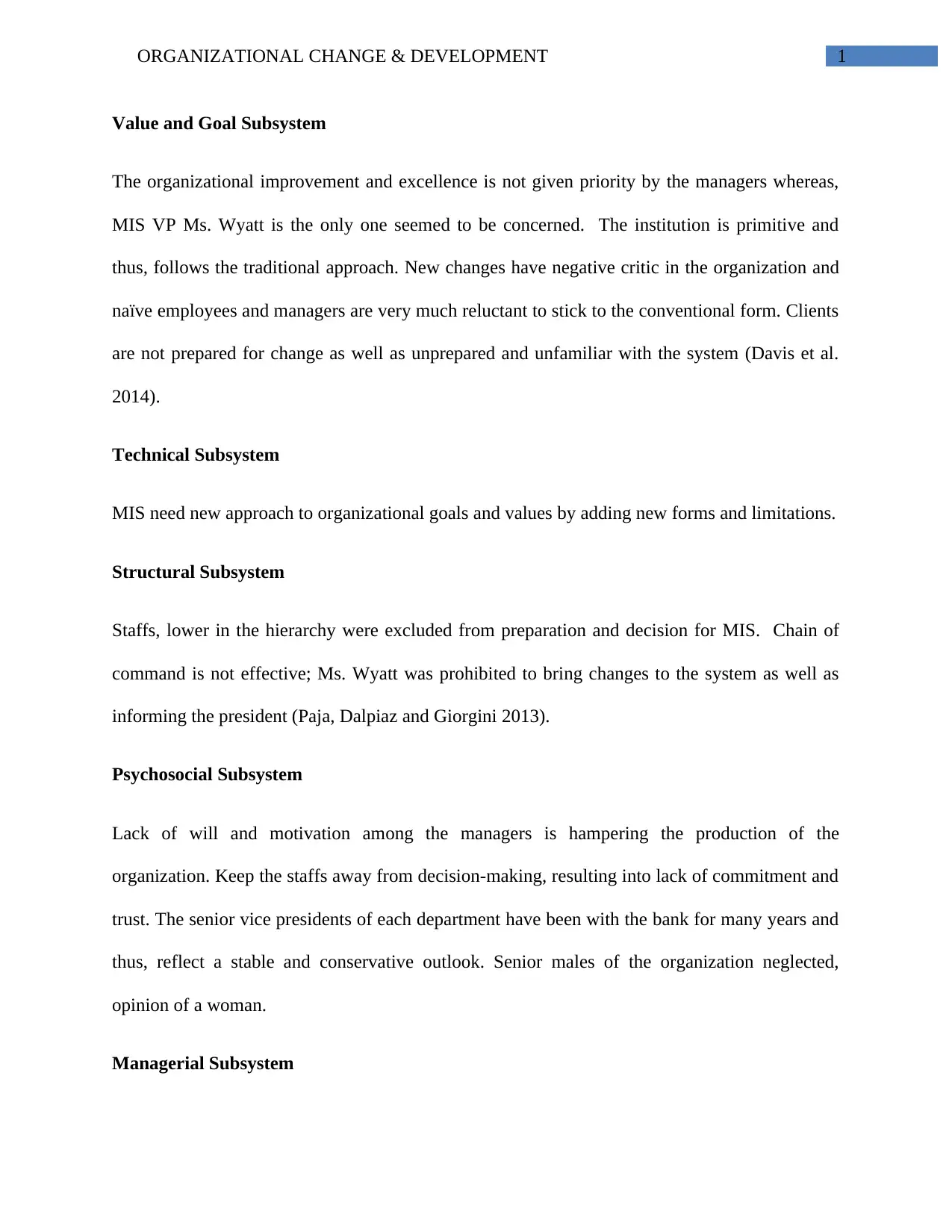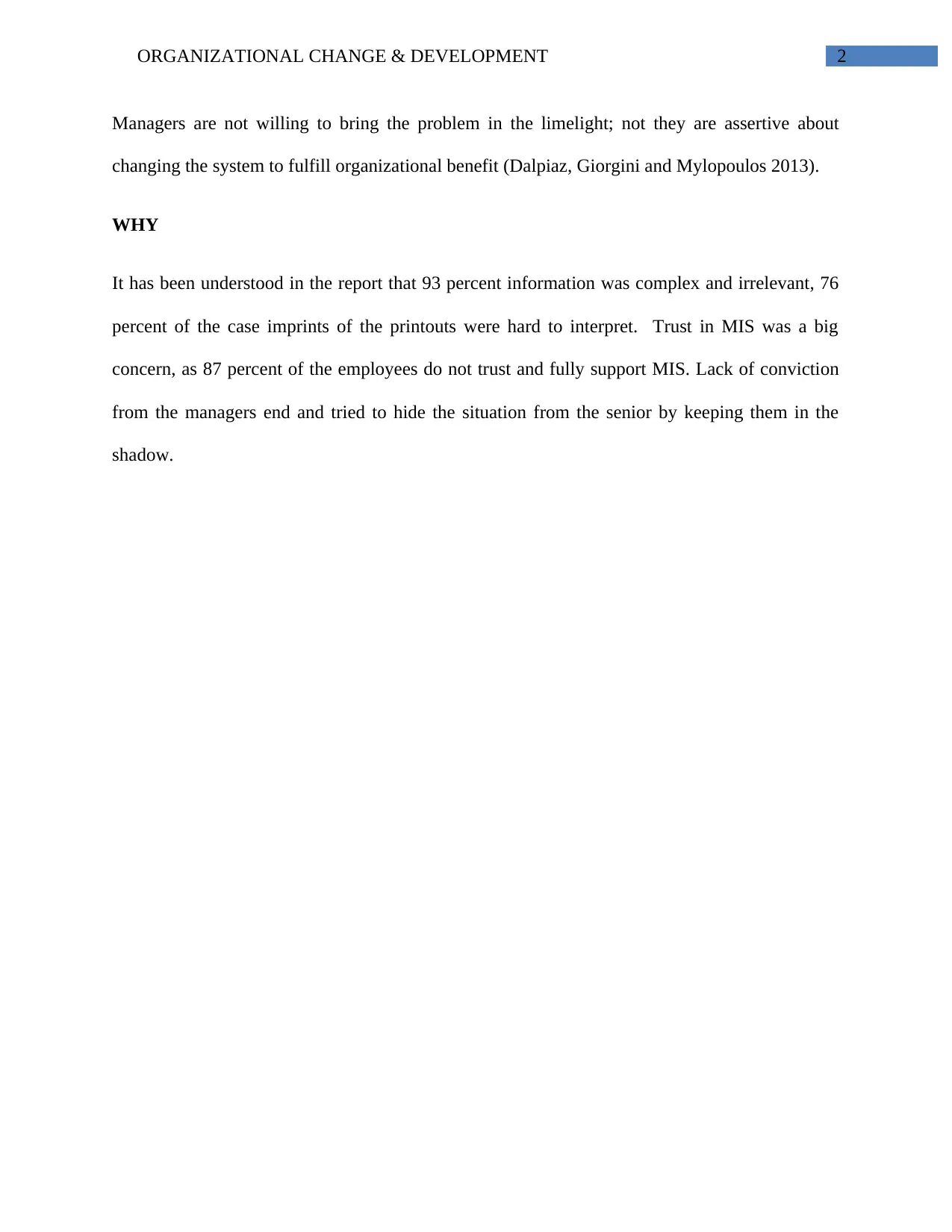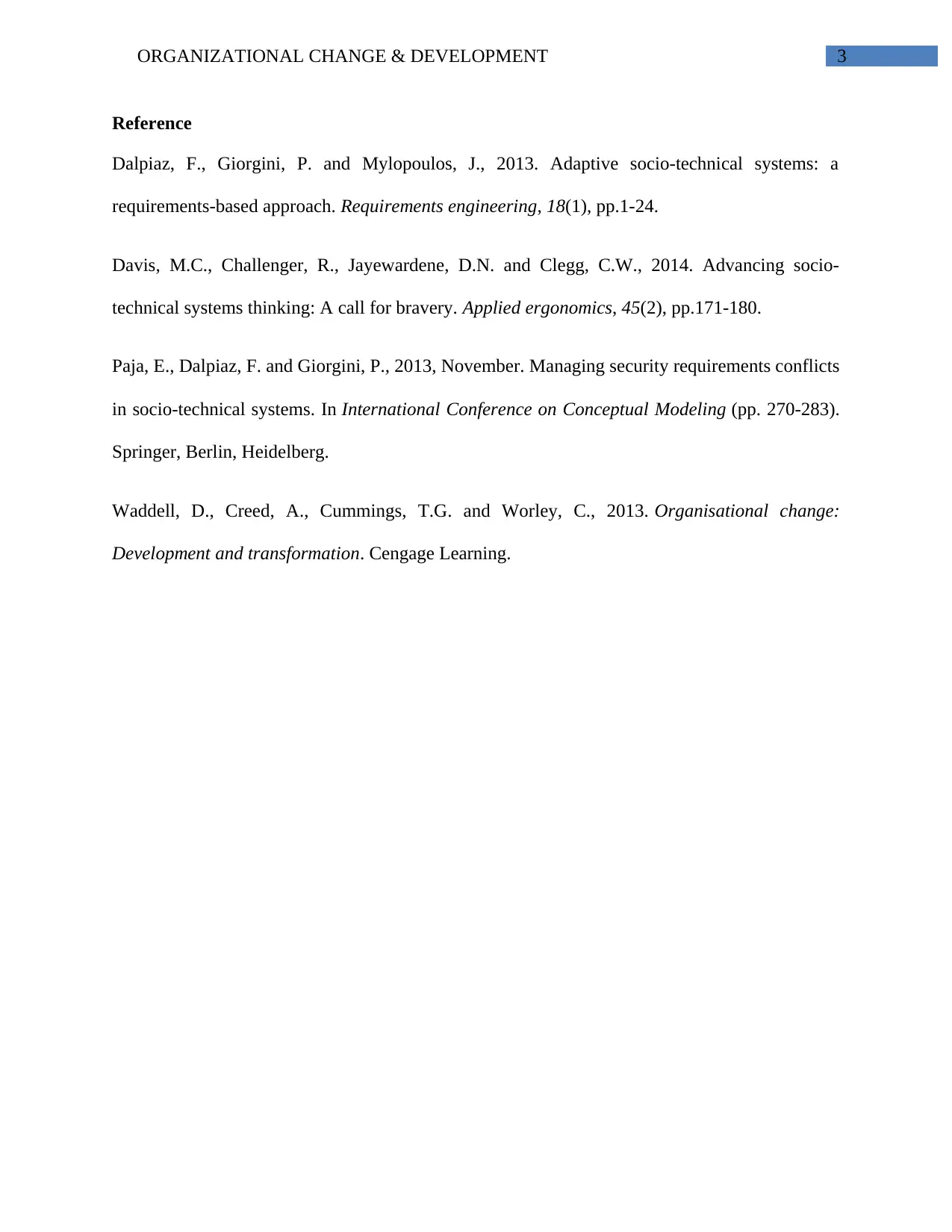Organizational Change & Development Report
VerifiedAdded on 2020/02/19
|4
|509
|247
Report
AI Summary
The report discusses the challenges and subsystems involved in organizational change and development, highlighting issues such as managerial reluctance, lack of trust in management information systems (MIS), and the exclusion of lower hierarchy staff from decision-making processes. It emphasizes the need for a new approach to organizational goals and values, addressing the psychosocial and technical aspects that hinder progress.

Running head: ORGANIZATIONAL CHANGE & DEVELOPMENT
Organizational Change & Development
Name of the student
Name of the university
Author’s Note
Organizational Change & Development
Name of the student
Name of the university
Author’s Note
Paraphrase This Document
Need a fresh take? Get an instant paraphrase of this document with our AI Paraphraser

ORGANIZATIONAL CHANGE & DEVELOPMENT 1
Value and Goal Subsystem
The organizational improvement and excellence is not given priority by the managers whereas,
MIS VP Ms. Wyatt is the only one seemed to be concerned. The institution is primitive and
thus, follows the traditional approach. New changes have negative critic in the organization and
naïve employees and managers are very much reluctant to stick to the conventional form. Clients
are not prepared for change as well as unprepared and unfamiliar with the system (Davis et al.
2014).
Technical Subsystem
MIS need new approach to organizational goals and values by adding new forms and limitations.
Structural Subsystem
Staffs, lower in the hierarchy were excluded from preparation and decision for MIS. Chain of
command is not effective; Ms. Wyatt was prohibited to bring changes to the system as well as
informing the president (Paja, Dalpiaz and Giorgini 2013).
Psychosocial Subsystem
Lack of will and motivation among the managers is hampering the production of the
organization. Keep the staffs away from decision-making, resulting into lack of commitment and
trust. The senior vice presidents of each department have been with the bank for many years and
thus, reflect a stable and conservative outlook. Senior males of the organization neglected,
opinion of a woman.
Managerial Subsystem
Value and Goal Subsystem
The organizational improvement and excellence is not given priority by the managers whereas,
MIS VP Ms. Wyatt is the only one seemed to be concerned. The institution is primitive and
thus, follows the traditional approach. New changes have negative critic in the organization and
naïve employees and managers are very much reluctant to stick to the conventional form. Clients
are not prepared for change as well as unprepared and unfamiliar with the system (Davis et al.
2014).
Technical Subsystem
MIS need new approach to organizational goals and values by adding new forms and limitations.
Structural Subsystem
Staffs, lower in the hierarchy were excluded from preparation and decision for MIS. Chain of
command is not effective; Ms. Wyatt was prohibited to bring changes to the system as well as
informing the president (Paja, Dalpiaz and Giorgini 2013).
Psychosocial Subsystem
Lack of will and motivation among the managers is hampering the production of the
organization. Keep the staffs away from decision-making, resulting into lack of commitment and
trust. The senior vice presidents of each department have been with the bank for many years and
thus, reflect a stable and conservative outlook. Senior males of the organization neglected,
opinion of a woman.
Managerial Subsystem

ORGANIZATIONAL CHANGE & DEVELOPMENT 2
Managers are not willing to bring the problem in the limelight; not they are assertive about
changing the system to fulfill organizational benefit (Dalpiaz, Giorgini and Mylopoulos 2013).
WHY
It has been understood in the report that 93 percent information was complex and irrelevant, 76
percent of the case imprints of the printouts were hard to interpret. Trust in MIS was a big
concern, as 87 percent of the employees do not trust and fully support MIS. Lack of conviction
from the managers end and tried to hide the situation from the senior by keeping them in the
shadow.
Managers are not willing to bring the problem in the limelight; not they are assertive about
changing the system to fulfill organizational benefit (Dalpiaz, Giorgini and Mylopoulos 2013).
WHY
It has been understood in the report that 93 percent information was complex and irrelevant, 76
percent of the case imprints of the printouts were hard to interpret. Trust in MIS was a big
concern, as 87 percent of the employees do not trust and fully support MIS. Lack of conviction
from the managers end and tried to hide the situation from the senior by keeping them in the
shadow.
⊘ This is a preview!⊘
Do you want full access?
Subscribe today to unlock all pages.

Trusted by 1+ million students worldwide

ORGANIZATIONAL CHANGE & DEVELOPMENT 3
Reference
Dalpiaz, F., Giorgini, P. and Mylopoulos, J., 2013. Adaptive socio-technical systems: a
requirements-based approach. Requirements engineering, 18(1), pp.1-24.
Davis, M.C., Challenger, R., Jayewardene, D.N. and Clegg, C.W., 2014. Advancing socio-
technical systems thinking: A call for bravery. Applied ergonomics, 45(2), pp.171-180.
Paja, E., Dalpiaz, F. and Giorgini, P., 2013, November. Managing security requirements conflicts
in socio-technical systems. In International Conference on Conceptual Modeling (pp. 270-283).
Springer, Berlin, Heidelberg.
Waddell, D., Creed, A., Cummings, T.G. and Worley, C., 2013. Organisational change:
Development and transformation. Cengage Learning.
Reference
Dalpiaz, F., Giorgini, P. and Mylopoulos, J., 2013. Adaptive socio-technical systems: a
requirements-based approach. Requirements engineering, 18(1), pp.1-24.
Davis, M.C., Challenger, R., Jayewardene, D.N. and Clegg, C.W., 2014. Advancing socio-
technical systems thinking: A call for bravery. Applied ergonomics, 45(2), pp.171-180.
Paja, E., Dalpiaz, F. and Giorgini, P., 2013, November. Managing security requirements conflicts
in socio-technical systems. In International Conference on Conceptual Modeling (pp. 270-283).
Springer, Berlin, Heidelberg.
Waddell, D., Creed, A., Cummings, T.G. and Worley, C., 2013. Organisational change:
Development and transformation. Cengage Learning.
1 out of 4
Your All-in-One AI-Powered Toolkit for Academic Success.
+13062052269
info@desklib.com
Available 24*7 on WhatsApp / Email
![[object Object]](/_next/static/media/star-bottom.7253800d.svg)
Unlock your academic potential
Copyright © 2020–2025 A2Z Services. All Rights Reserved. Developed and managed by ZUCOL.
